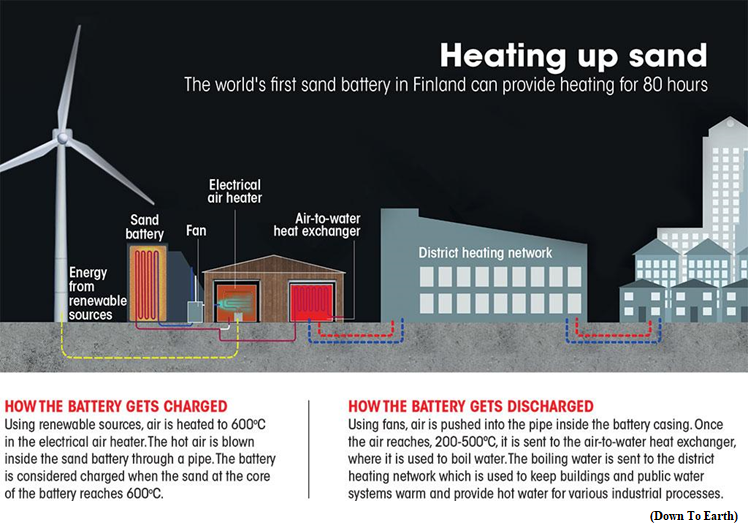Finland’s installation of the world’s 1st sand battery (GS Paper 2, International Relation)

Why in news?
- Recently, Finland has installed the world’s first sand battery that can store heat from renewable energy sources for months.
- The battery, made of sand collected from construction sites, can solve the problem of round-the-year energy supply, a known limitation of renewable energy sources that can be harnessed intermittently.
Details:
- This is a major breakthrough, as heat alone accounts for half of the world’s energy use, followed by transport (30 per cent) and electricity (20 per cent), as per International Energy Agency (IEA). Currently, 80 per cent of the world’s energy comes from dirty fossil fuels.
- The battery, a massive steel silo, 7 m tall and 4 m wide with 100 tonnes of sand, was installed in Finland’s Kankaanpää town in June 2022. It is connected to the town’s centralised heating network that keeps buildings and public water systems warm.
- Owing to the cold temperature, all municipalities and cities in Finland have centralised heating networks, and 70 per cent of them use renewable sources.
Advantages of opting sand:
- The renewable sector has several water-based storage systems that can heat buildings for short durations. But the Finnish researchers decided to replace water with sand because of its advantages.
How it works?
- Sand can be heated up to 600 degrees Celsius (°C), whereas water starts to boil at 100°C. It also has low heat conductivity, which reduces energy loss.
- The storage system has three main components: the sand silo, an electrical air heater and an air-to-water heat exchanger. For charging the sand silo, air is heated to 600°C in the electrical air heater.
- The hot air is then circulated inside the silo using a heat-exchange pipe and blowers to raise the temperature of the sand at the silo’s core to 600°C. When the storage enters the discharging stage, the blowers are used to pump air into the pipe inside the sand silo.
- Once the air reaches 200°C, it is transferred to the air-to-water heat exchanger, where it is used to boil water. It is then sent to the heating network.
- The storage system requires electricity at all times. It is needed to charge the battery, monitor the temperature during standby and run the blowers when the battery is used.
Storage capacity:
- The installed battery can store 8 megawatt-hours (MWh) of energy and release heat at 0.1 MW; enough to provide heating and hot water for about 100 homes and a public swimming pool in Kankaanpää for 80 hours on a full charge.
- They are developing a 200 MWh battery that can discharge heat at the rate of 2 MW (enough to meet the heating need of 100 Kankaanpää houses), with a discharge time of 100 hours.
- The technology is promising, but its current capacity is not enough to meet the heating needs of an entire season.
Way Forward:
- The Finnish company believes that the battery has a huge potential, even in countries without district heating networks.
- In India, for instance, the battery provides big opportunities for process heating in industries, or heating municipal building complexes. It can be set up for any industry that requires more than 10,000 MWh heating in a year.
Jindal Steel gets India’s first BIS licence to make fire-resistant steel
(GS Paper 3, Economy)
Why in news?
- Recently, Jindal Steel and Power (JSP) has received Bureau of Indian Standards (BIS) certification to manufacture India’s first fire-resistant steel structures at its rail mill and special profile mill in Raigarh, Chhattisgarh.

Key Highlights:
- The hot rolled structural steel, manufactured as per IS 15103, can be used for high-temperature or fire-prone areas and can withstand temperatures up to 600 degrees Celsius for a maximum duration of three hours.
- Fire protection has been a challenge in the design of steel structures. The availability of fire-resistant steel will result in more efficient designs of structures.
- The new BIS 15103 grade will be used to manufacture steel structures for infrastructure projects such as industrial structures, refineries, bridges, metro projects, and steel and power plants as well as in hospitals, and commercial and residential buildings.
About JSP:
- JSP is an industrial powerhouse with a dominant presence in the steel, mining and infrastructure sectors.
- With an investment of USD 12 billion across the globe, the company said it was continuously scaling its capacity utilisation and efficiencies to capture opportunities for building a self-reliant India.



